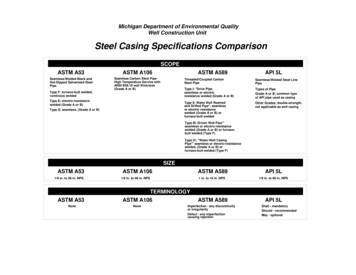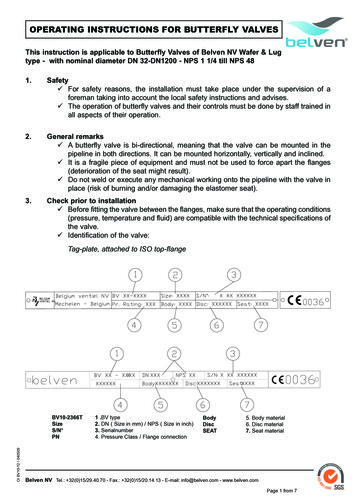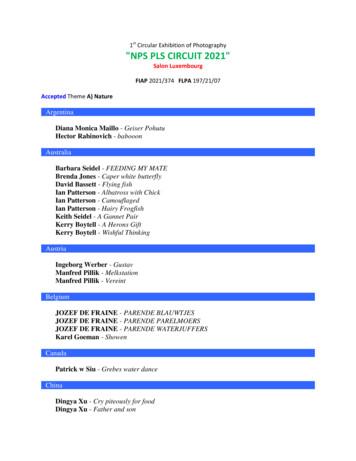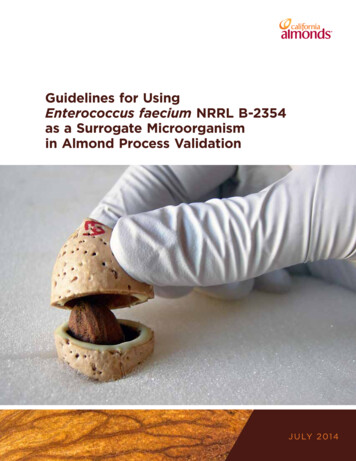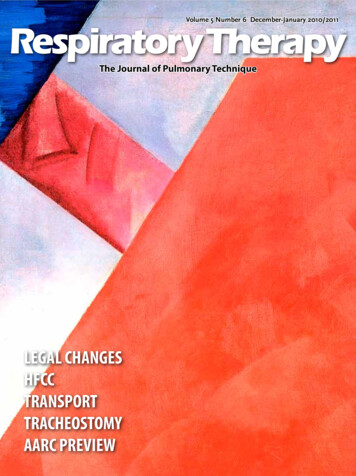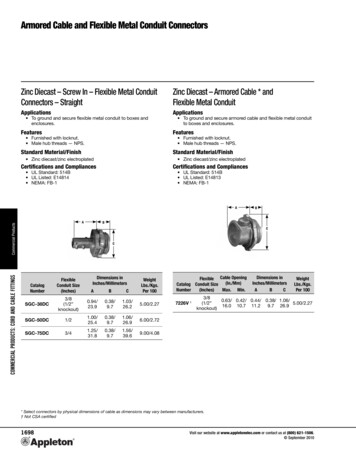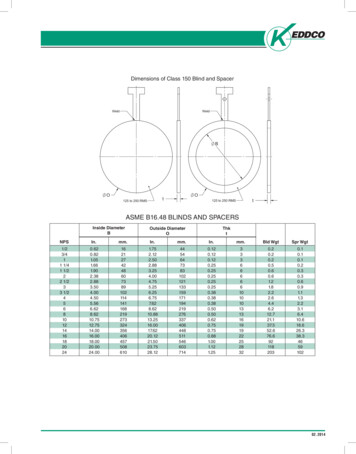
Transcription
National Park ServiceU.S. Department of the InteriorZion National ParkWhat is a Microorganism?Introduction to MicroorganismsNPS/MARC NEIDIG
ContentsIntroduction 2Background 2ActivitiesHow Small is Small? 3Mystery Microorganisms 4Microorganisms Are Everywhere –Even in Zion National Park! 6Glossary 8References 8
IntroductionThis guide contains background information about what microorganismsare and directions for three activities that will help students betterunderstand microorganisms and how they relate to everyday life andZion National Park. The activities are most beneficial to students whencompleted in order. This guide is specifically designed for sixth gradeclassrooms, but the activities can be modified for students at other levels.ThemeThough they cannot be seen with thenaked eye, there are millions of diversemicroorganisms living everywhere around us,performing a variety of important functions.FocusThis activity guide provides the definition, andexplores examples of microorganisms, and theplaces microorganisms are found.ActivitiesHow Small is Small?By using a large scale, students will be ablemodel the size of specific microorganisms andcompare them with the size of a human hair.Activity MaterialsCorresponding materialswhich may include images,worksheets, and answer keysare available for each activity.Materials can be downloadedfrom the lesson plan webpage,found here.Mystery MicroorganismsCore ConnectionsStudents will use a description and phototo categorize a species of microorganismand determine where it might live in ZionNational Park.Utah Core CurriculumSixth Grade ScienceStandard 5: Studentswill understand thatmicroorganisms range fromsimple to complex, are foundalmost everywhere, and areboth helpful and harmful.Objective 1: Observe andsummarize information aboutmicroorganisms.Objective 3: Identify positiveand negative effects ofmicroorganisms and howscience has developed positiveuses for some microorganismsand overcome the negativeeffects of others.Zion National Park, April 2014Students will learn about the five categories ofmicroorganisms by classifying a set of species(their “Mystery Microorganisms”).Microorganisms Are Everywhere –Even in Zion National Park!BackgroundJust as there are millions of differentspecies of plants and animals in the world,there are millions of different species ofmicroorganisms. Microorganisms can survivein environments where humans are unableto live. Microorganisms exist throughout theworld, from Antarctica to your kitchen, frominside animals, like humans, to the expansivewilderness in Zion National Park.A microorganism is defined as a living thingthat is so small it must be viewed with amicroscope. Some microorganisms like virusesare so small they can only be seen with specialelectron microscopes.There are five different categories ofmicroorganisms—bacteria, algae, protozoa,fungi, and viruses—explained in further detailin Mystery Microorganisms. Microorganismscover almost all the kingdoms of life. Bacteriaand some algae are in the Monera kingdom(sometimes divided into the separateEubacteria and Archaebacteria kingdoms),algae and protozoa are in the Protistakingdom, and fungi make up their ownkingdom. There is ongoing debate about howto classify most microorganisms (for instance,some scientists put some types of algae in thePlant kingdom while others do not).Microorganisms of all kinds can be found inZion National Park and southern Utah. Inmany cases, these microorganisms can actuallybe seen at work, such as the fungi, algae, andbacteria that build up the fragile spires ofbiological soil crust, or the algae which givesthe Emerald Pools a green color.Microorganisms are also prevalent inside us.While we like to think of ourselves as beingmade up of human cells, we are actually90% microbial: there are 10 times more cellsfrom microorganisms in our bodies thanhuman cells. That means there are trillionsof microorganisms living inside us every day.Most are helpful to us, such as bacteria thathelp us digest our food. Scientists now thinkthat a diversity of microorganisms inside of ushelp us resist many diseases.What is a Microorganism? 2
How Small is Small?Duration45 MinutesLocationOutside or inside area with a large open spaceKey VocabularyNIHorganism, microorganism, single-celled, algae,bacteria, fungi, protozoa, virusObjectivesStudents will be able to conceptualize the sizeof microorganisms and give a definition ofwhat a microorganism is.MethodPROYECTO AGUAThe rod shape of E. coli can beclearly seen under a scanningelectron microscope.Micrasterias americana algae at400x magnification.3. Go outside or into your open space, anduse the meter stick to measure an area 1meter long. Mark it with chalk, string, ortape (depending on your location). Onemeter represents the 0.1 millimeter widthof a hair using the scale of 10,000 :1.4. Using the information below, add differentmicroorganisms to the ground or paper.Students can measure out the size and labelthe different cells and microorganisms:By using a large scale, students will be ablemodel the size of specific microorganisms andcompare them with the size of a human hair.Human red blood cell (.01 mm) 10 cmBackgroundScenedesmus (algae) (0.03 mm) 30 cmThe average human hair is 0.1 millimeterswide, and barely discernable with the nakedeye. Microorganisms are many hundreds tothousands of times smaller and by definitioncan only be seen under a microscope.Most microorganisms consists of only onecell and they are known as single-celledorganisms (in comparison, humans consistof trillions of different cells). Differentspecies of microorganisms vary in size, shape,appearance, and way of surviving.E. coli bacteria (.002 mm) 2 cmThe largest microorganisms are most fungiand many species of protozoa. Viruses areby far the smallest of all microorganisms. Ifa virus was the size of a baseball, an averagebacterium would be the size of a pitcher’smound, and one single human cell would bethe size of the entire stadium!Materials meter stick or ruler magnifying glass marking material for ground (i.e. sidewalkchalk, markers, or string) a hair from a human head 5 meters of butcher paper (if inside)Suggested Procedure1. Introduce the idea of what microorganismsare and that they cannot be seen with thenaked eye.Zion National Park, April 20142. Have students examine a human hair (onecan be passed around and/or students canexamine their own). Students can lookat how thin the hair is with and withoutmagnifying glasses.Paramecium (protozoa) (0.2 mm) 2 mEuglenoids (algae) (0.4 mm) 4 mStaphylococcus bacteria(.0005 mm) 0.5 cmPolio virus (.00002) .2 mm (a tiny dot)5. When finished measuring out all themicroorganisms, compare their sizes.Notice how viruses are the smallest typebut other types vary in size depending onthe species. Students can draw their ownreference models on paper to keep.6. Finish by asking students (verbally or inwriting) why scientists have to use modelslike this (because some microorganismsare too small to be seen under regularmicroscopes and it is difficult tocompare sizes and features of a variety ofmicroorganisms because of their size).ExtensionHave students research the size of othermicroorganisms to compare size and practicemath skills using the 10,000:1 scale.Find large items to compare microorganismsto such as a pencil, a school bus, or a footballfield. For instance, if the 2,000 foot tall cliffs ofZion Canyon were on the scale, they would beover 3,800 miles long, the distance from LasVegas to Chicago and back!What is a Microorganism? 3
MysteryMicroorganismsDuration45 MinutesLocationInsideROBIN SKey Vocabularyorganism, microorganism, single-celled, algae,bacteria, fungi, protozoa, virus, producer,decomposerObjectivesStudents will be able to list the five differenttypes of microorganisms and share the specificattributes of at least one type.HHSMethodStudents will learn about the five categories ofmicroorganisms by classifying a set of species(their “Mystery Microorganisms”) as one ofthe types of microorganisms.Backgroundthey reproduce using spores, tiny, seed-likecells. Most fungi are multicellular, but otherssuch as yeast are single-celled. Most cells offungi are loosely connected through threadlike filaments called hyphae. Fungi is plural,fungus is singular.Protozoa: The name protozoa means “firstanimal,” and describes this microorganism’sability to move and hunt. Protozoa aremembers of the Protista kingdom. Ciliates,amoebae, and flagellates all are categoriesof protozoa and all are single-celled. Mostprotozoa do not cause disease but there area few that cause harm to humans, includingPlasmodium (malaria) and Giardia. Theseprotozoa are considered parasites. Protozoa isplural, protozoan is singular.Viruses: There is some debate on whetherviruses are actually organisms at all; that is,whether they are alive or not. While theyhave DNA or RNA and infect a host likeother parasites, viruses have no true cells andcannot reproduce on their own. Viruses isplural, virus is singular.Generally, there are five categories ofmicroorganisms (simpler definitions arelocated in the glossary for student use):MaterialsBacteria: These microorganisms are theoldest living things on Earth, and have beenaround an estimated 3 billion years (scientistshave found fossils of cyanobacteria). Theycome in a variety of shapes (spheres, rods,or spirals) and are a diverse set of organisms.However, all of them are prokaryotes (theylack a nucleus). Bacteria is plural, bacterium issingular.Suggested Procedure Mystery Microorganism Clues sheets Large (8.5 x 11) envelopesNPS/BRYANNA PLOGDigital interpretation ofrhinovirus.Aspergillus fumigatusas, a fungi,visible under a microscope.Algae color the water green atthe Emerald Pools.Algae: While not all algae are green, allalgae are capable of photosynthesizing andare producers. However, most algae are notplants, and the majority are in the Protistakingdom. Like plants, algae produce oxygenand account for about 70% of all the oxygenproduced on Earth. Algae can be single-celledor multicelled. Algae mostly grow in water andinclude seaweed and “pond scum.” Algae isplural, alga is singular.Fungi: All fungi are decomposers, breakingdown dead matter for nutrients, and theycannot produce their own food. Fungi aredistinguished from other decomposers in thatZion National Park, April 20141. Prepare “mystery packets” ahead of timeusing the Mystery Microorganism Cluessheets. Print one set of each and put themin large envelopes labeling them “MysteryMicroorganism #1,” etc. Each packetshould have two or three photos all fromthe same grouping (virus, bacteria, etc.). Ifstudents have access to laptop computersor tablets, photos could be loaded andviewed digitally.Mystery Microorganism #1 (Virus) HIV/AIDS The common cold ChickenpoxMystery Microorganism #2 (Bacteria) Yogurt E. Coli StreptococcusWhat is a Microorganism? 4
Mystery Microorganism #3 (Protozoa) Malaria (Plasmodium) Amoeba proteusMystery Microorganism #4 (Fungi) Bread mold Penicillin MushroomsMystery Microorganism #5 (Algae) Algae on a pond Algae (microscope photos)2. Write the five different categories ofmicroorganisms on the board, with thedefinition underneath (write on a whiteboard or print out and put up). Go over thedefinition of each type of microorganismwith the class:ExtensionAsk the class a question to help furtherdefine the different categories and have thegroup stand up if the description fits theirmicroorganism. Questions could include: Isyours a decomposer? A producer? Whichones are alive? Which ones can cause disease?Which can be treated by antibiotics?Have students explore different types oforganisms online. Suggested site: “Whatand where are micro-organisms” on: acteria: single-celled organisms that areshaped like spheres, rods or spiralsProtozoa: single-celled parasites that actlike animals (feed on and destroy bacteriaand other organisms)Fungi: decomposers that break downmatter, including bacteriaAlgae: single-celled and plant-likeViruses: non-living; cause many diseases3. Divide the class into five groups and giveeach group one of the mystery packets.Each group has to figure out the categoryfor their microorganisms. Give each groupa few minutes to determine which categoryof microorganism they think they have.Tell them to be prepared to share theirreasoning with the class.4. Once allotted time is up (5 minutes orwhen all groups are finished), groups willshare their conclusions. You can go groupby group (i.e. which microorganism do youthink your group has?), or by the type ofmicroorganism (which group thinks theyhave algae?). Have each group come tothe front and explain how their examplesfit the definition for their microorganism.If there is room on the board, have eachgroup place their photos up under thecorrect label and definition.Zion National Park, April 2014What is a Microorganism? 5
Microorganisms AreEverywhere Even inZion National Park!Duration45 MinutesLocationInsideKey Vocabularyalgae, bacteria, fungi, protozoa, virus,decomposer, producerObjectivesStudents will be able to use their knowledgeof different types of microorganisms tosuccessfully categorize and describe specificmicroorganisms and infer what type ofenvironment they might live in.MethodStudents will use a description and photo tocategorize a species of microorganism anddetermine where it might live in Zion NationalPark.Backgroundeven survive radiation levels 10,000 timeshigher than humans. Certain microorganismsprefer water, others soil, and still others liveinside other living things.Trillions of microorganisms live inside humansand other animals. Most microorganisms arehelpful to us (and other animals), such as thebacteria that help us digest food. Scientistsnow think that a diversity of microorganismsinside our bodies help us resist many diseases.One reason microorganisms have been aroundfor billions of years is because they are ableto thrive in all types of environments. In onegram of soil, for instance, there are around 40million individual bacteria.In dry areas like Zion National Park, bacteriapair with cyanobacteria (blue-green algae),fungi, algae, lichens, and mosses to create afragile soil crust called biological soil crust.Biological soil crusts help prevent erosionand retain water and serve many importantfunctions in Zion National Park and otherdesert areas. Microorganisms can also beseen in Zion National Park in areas likethe Emerald Pools where algae grow inabundance.Microorganisms are found all over the worldand can survive in a variety of extremeconditions. They are found in steam vents,boiling mud pots, and Antarctica. Some canNPS/BRYANNA PLOGZion National Park, April 2014What is a Microorganism? 6
Materials Microorganisms Are Everywhere photosand reference sheet Microorganisms in Zion Descriptionsand WorksheetSuggested ProcedureNPSNPS/BRYANNA PLOGGrand Prismatic Spring inYellowstone National ParkBiological soil crust forms whenbacteria, algae, and fungicombine.1. Go over and show some of the differentand extreme places microorganismscan live throughout the world (“WhereMicroorganism Live” document). Explainthat microorganisms thrive everywhere:some can live in the most extreme ofenvironments, but different species thrivein different environments. Alternatively,students could present each environmentin turn instead of the teacher.2. Randomly assign students one of thefive microorganisms on theMicroorganism Descriptions sheets(Rhizobia, Streptococcus bovis, Spirogyra,Aspergillus, and Giardia). Hand outprinted copies or display the“Microorganism Descriptions” sheetsabout each microorganism so students cansee the information.3. Give each student a “Microorganisms inZion” worksheet and have them use theinformation from the MicroorganismDescriptions sheets to complete theinformation. Allow them around 15minutes to work.4. Once students are done, group themtogether by the microorganism. Allow themtime to discuss their answers with eachother and sort out any disagreements.5. Have each group present their findings andtheir microorganism.ExtensionStudents can further research theirmicroorganism and write or share moreinformation about it with the class (e.g.why the role of nitrogen-fixing bacteria likeRhizobia is important or how to preventgetting sick from Giardia).Zion National Park, April 2014What is a Microorganism? 7
GlossaryReferencesalgae: single-celled plant-like organisms. Theyproduce their own food using photosynthesis.American Society for Microbiology. “Let’s GetSmall.” Last modified periment/experiment letsget small.aspxbacteria: single-celled organisms that belongto the Monera kingdom. They can be shapedlike spheres, rods, or spirals and can doeverything from decompose dead leaves tocause disease.decomposer: an organism that feeds on deador decaying organisms. They cannot producetheir own food but get their energy frombreaking down dead organisms.fungi: a type of decomposer that reproducesthrough tiny seed-like cells called spores.While some fungi like mushrooms and moldsare large, other types of fungi are single-celled.microorganism: an organism that is so smallit can only be viewed under a microscope(not with the naked eye). They usually arenot plants or animals and come in a variety oftypes, species, sizes, and shapes.organism: any living thing, large or small. Allorganisms need air, water, and energy and cangrow and reproduce.producer: an organism which can produceits own food using the energy from the sun tophotosynthesize.Genetic Science Learning Center. “ExtremeEnvironments: Great Salt Lake. Lastmodified January 2014. opy UK. “Pond Life IdentificationKit.” Last modified 1999. National Park Service: Arches National Parkand Canyonlands National Park. “LessonPlans: Microorganisms in the srooms/6th microorganisms.htmThe University of Manchester. “Microorganisms.” Last modified isms/Utah Education Network. Utah CoreStandards: “Science, 6th GradeCore.” http://www.uen.org/core/core.do?courseNum 3060protozoa: single-celled parasites that actlike animals (feed on and destroy othermicroorganisms).single–celled: an organism that is made up ofonly one cell; in contrast, humans are made upof trillions of cells.virus: non-living agent of disease. Canmultiply and cause harm to the living thing itinfects.Zion National Park, April 2014What is a Microorganism? 8
Zion National Park, April 2014 What is a Microorganism? 4 Digital interpretation of rhinovirus. Aspe
